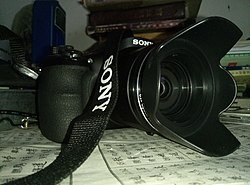 | |
| Overview | |
|---|---|
| Maker | Sony |
| Lens | |
| Lens | 25-1550mm equivalent |
| F-numbers | f/3.4-f/6.5 at the widest |
| Sensor/medium | |
| Sensor type | CCD |
| Sensor size | 6.17 x 4.55mm (1/2.3 inch type) |
| Maximum resolution | 5152 x 3864 (20 megapixels) |
| Film speed | 80-3200 |
| Recording medium | SD, SDHC, or SDXC memory card, or Memory Stick PRO Duo/Pro-HG Duo |
| Shutter | |
| Shutter speeds | 1/2000s to 30s |
| Continuous shooting | 1 frame per second |
| Viewfinder | |
| Frame coverage | 100% |
| Image processing | |
| Image processor | Bionz(R) |
| White balance | Yes |
| General | |
| Video recording | 720p at 30fps |
| LCD screen | 3 inches with 460,000 dots |
| Dimensions | 130 x 95 x 122mm (5.1 x 3.74 x 4.81 inches) |
| Weight | 655 g (23 oz) including battery |
The Sony Cyber-shot DSC-H400 is a DSLR-like ultrazoom bridge camera announced by Sony on February 13, 2014. At the time of its release, it was the compact camera with the longest reach, with a maximum equivalent focal length of 1550mm. In March 2015, the Nikon Coolpix P900 was released with 2000mm equivalent maximum focal length. [1]